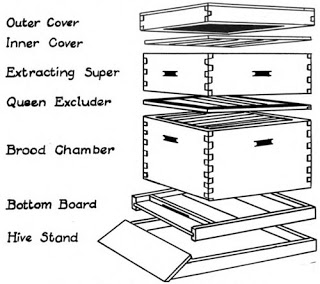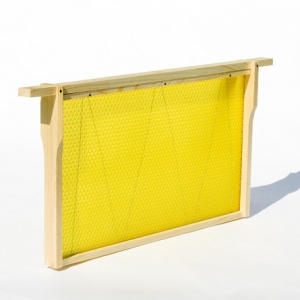What makes up the hive?
We have to get the new hive out of the box soon. It’s been so cold here and yesterday we had intended to take it up to the apiary but it snowed. Now, I happen to know that some of you reading this are in Alaska and are probably thinking ‘Why would this stop you?’ since really it was just English snow – maybe 6ins covering but as anyone living in England knows a little bit of snow is enough to bring most of the country to a standstill.
In our defence the apiary is up a tiny track, behind a beautiful but very old – we are talking 16th century church and down a footpath between huge trees. It would have looked fantastic covered in snow but it would have been inaccessible.
So, back to whats in the box. We have a Thorne National Hive (feel free to advertise Thorne!) with DN4 frames. Oooh, that was a bit technical. Let’s start with a rough idea of what we have. The diagram is a National hive, usually the most practical, cheaper and easiest hive, in my humble opinion. There is much discussion amongst beekeepers as to what is the best hive. It’s not a conversation to start if you need to be somewhere else anytime soon. The National one looks like a pile of boxes, rather an a beehive. Not the pretty white pitch roofed affair you imagine or have seen in Winnie the Pooh!
The top has a metal outer cover, to protect against weather and robbers. Then there is the crown board, known in the diagram as the inner cover. Next follows the extracting super which we just call the super – but this is where the honey comes from – and then the Queen Excluder. This last item is really important as it stops the queen from getting into the super and laying eggs. Once she does that you cannot have the honey unless you like eggs and larvae mixed in with it.
The brood chamber is where the queen is supposed to lay her eggs and where they grow into new bees. This is all we have just now, we don’t have a super as we are establishing our hive. In the summer the super will go on. The bottom board might be solid or a mesh (ours is a mesh) and the hive stand keeps the whole thing off the ground and dry, away from predators and helps your back when you are bending over the hive as it makes it a bit higher.
I mentioned the DN4 frames. We have chosen these are they are self spacing – it they leave just the right gap between each one for the ‘bee space’. Bee Space is between 6 and 9mm, the gap needed between the frames for bees to work, get past each other and generally do their thing. The exact figure is also hotly debated but anything smaller gets filled with propolis and anything larger gets filled with comb. This seems to be the space that bees work best with and is observed in wild colonies.
If you look at the top of the frame it is wider than the bottom, this creates the space.

